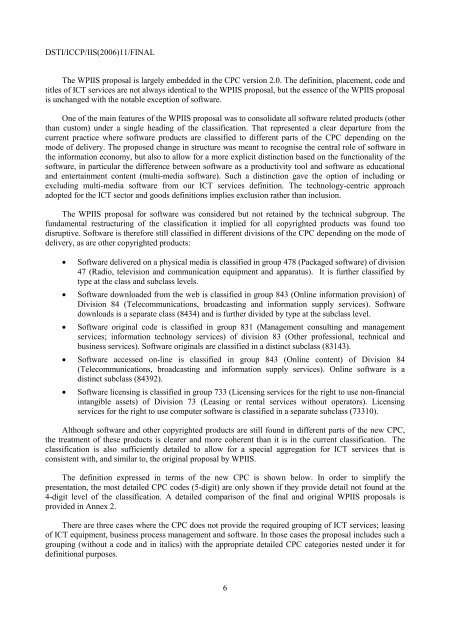Classifying Information and Communication Technology (ICT ...
Classifying Information and Communication Technology (ICT ...
Classifying Information and Communication Technology (ICT ...
You also want an ePaper? Increase the reach of your titles
YUMPU automatically turns print PDFs into web optimized ePapers that Google loves.
DSTI/ICCP/IIS(2006)11/FINAL<br />
The WPIIS proposal is largely embedded in the CPC version 2.0. The definition, placement, code <strong>and</strong><br />
titles of <strong>ICT</strong> services are not always identical to the WPIIS proposal, but the essence of the WPIIS proposal<br />
is unchanged with the notable exception of software.<br />
One of the main features of the WPIIS proposal was to consolidate all software related products (other<br />
than custom) under a single heading of the classification. That represented a clear departure from the<br />
current practice where software products are classified to different parts of the CPC depending on the<br />
mode of delivery. The proposed change in structure was meant to recognise the central role of software in<br />
the information economy, but also to allow for a more explicit distinction based on the functionality of the<br />
software, in particular the difference between software as a productivity tool <strong>and</strong> software as educational<br />
<strong>and</strong> entertainment content (multi-media software). Such a distinction gave the option of including or<br />
excluding multi-media software from our <strong>ICT</strong> services definition. The technology-centric approach<br />
adopted for the <strong>ICT</strong> sector <strong>and</strong> goods definitions implies exclusion rather than inclusion.<br />
The WPIIS proposal for software was considered but not retained by the technical subgroup. The<br />
fundamental restructuring of the classification it implied for all copyrighted products was found too<br />
disruptive. Software is therefore still classified in different divisions of the CPC depending on the mode of<br />
delivery, as are other copyrighted products:<br />
• Software delivered on a physical media is classified in group 478 (Packaged software) of division<br />
47 (Radio, television <strong>and</strong> communication equipment <strong>and</strong> apparatus). It is further classified by<br />
type at the class <strong>and</strong> subclass levels.<br />
• Software downloaded from the web is classified in group 843 (Online information provision) of<br />
Division 84 (Telecommunications, broadcasting <strong>and</strong> information supply services). Software<br />
downloads is a separate class (8434) <strong>and</strong> is further divided by type at the subclass level.<br />
• Software original code is classified in group 831 (Management consulting <strong>and</strong> management<br />
services; information technology services) of division 83 (Other professional, technical <strong>and</strong><br />
business services). Software originals are classified in a distinct subclass (83143).<br />
• Software accessed on-line is classified in group 843 (Online content) of Division 84<br />
(Telecommunications, broadcasting <strong>and</strong> information supply services). Online software is a<br />
distinct subclass (84392).<br />
• Software licensing is classified in group 733 (Licensing services for the right to use non-financial<br />
intangible assets) of Division 73 (Leasing or rental services without operators). Licensing<br />
services for the right to use computer software is classified in a separate subclass (73310).<br />
Although software <strong>and</strong> other copyrighted products are still found in different parts of the new CPC,<br />
the treatment of these products is clearer <strong>and</strong> more coherent than it is in the current classification. The<br />
classification is also sufficiently detailed to allow for a special aggregation for <strong>ICT</strong> services that is<br />
consistent with, <strong>and</strong> similar to, the original proposal by WPIIS.<br />
The definition expressed in terms of the new CPC is shown below. In order to simplify the<br />
presentation, the most detailed CPC codes (5-digit) are only shown if they provide detail not found at the<br />
4-digit level of the classification. A detailed comparison of the final <strong>and</strong> original WPIIS proposals is<br />
provided in Annex 2.<br />
There are three cases where the CPC does not provide the required grouping of <strong>ICT</strong> services; leasing<br />
of <strong>ICT</strong> equipment, business process management <strong>and</strong> software. In those cases the proposal includes such a<br />
grouping (without a code <strong>and</strong> in italics) with the appropriate detailed CPC categories nested under it for<br />
definitional purposes.<br />
6

















